SOUTH PEACE SENIOR HOCKEY
Fifty-eight years ago the Grande Prairie Athletics won the sixth and final SPHL championship game without breaking a sweat. They won the game by default.
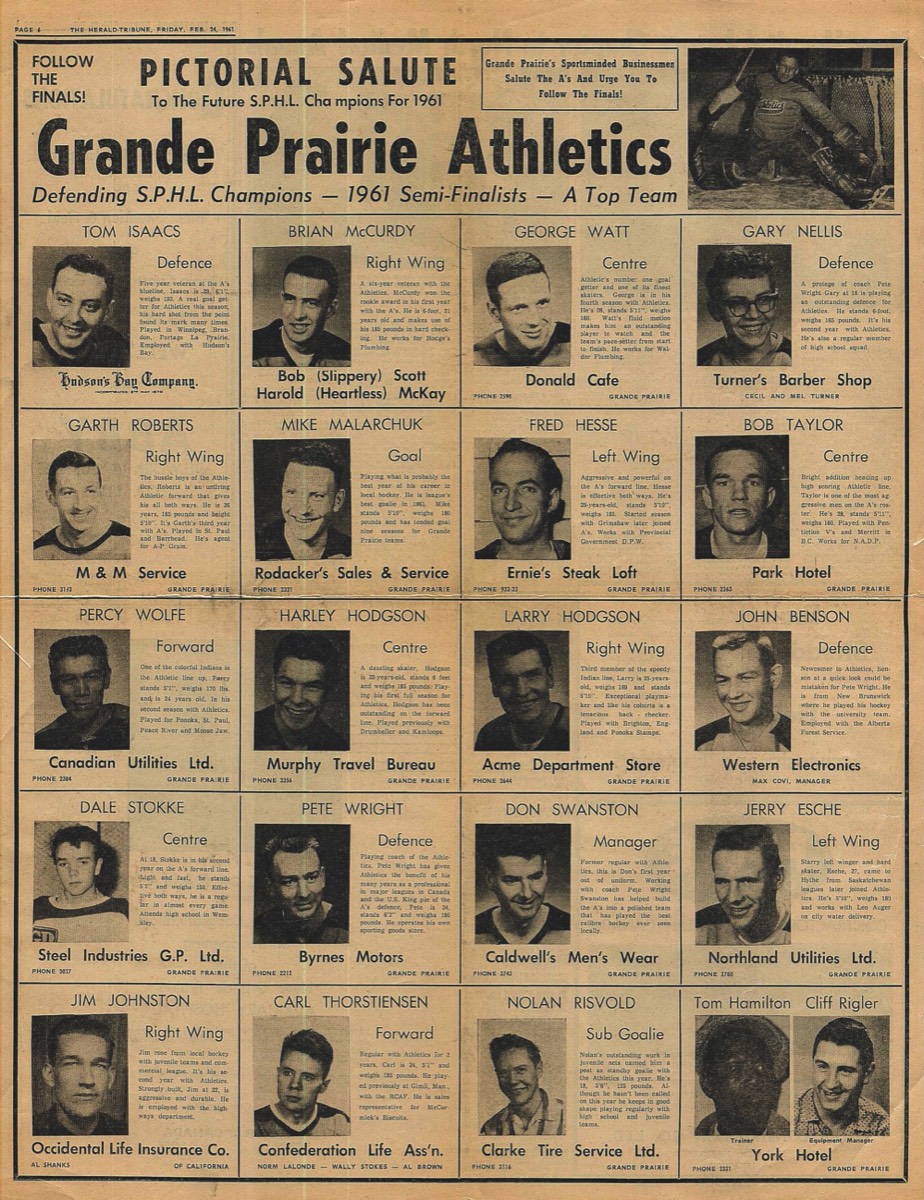
Grande Prairie Athletics, South Peace Hockey League Champions 1961. Submitted photo
The Grande Prairie Athletics win the NPHL championship the hard way – in overtime by a score of 3-2. It was also game six of the series.

Grande Prairie Athletics, North Peace Hockey League Champions 2019. Photo Stan Neufeld
A Hockey Series Determined in a Board Room
Remarkably Dawson Creek forfeited both the first and the sixth game of the 1961 SPHL playoffs. It was and is still remembered as a controversial series. Having come across the story of the SPHL playoffs fifty-eight years ago I determined to conduct my own investigation into the circumstances surrounding the series. I have scoured newspaper renderings of the incident – the Grande Prairie Herald and the Dawson Creek Star. I have been in touch with Harold, (better know as Flukey) Kjemhus, Ken White, Dale Stokke and Roy Borstad. All of them were directly involved in some manner with the 1961 series. I have had the privilege of reviewing a scrapbook loaned to me by Flukey, interviewed Dale, Ken and Roy, and studied photographs pertaining to the series. Following are several perspectives pertaining to the 1961 playoffs and related information that sheds light on our colourful hockey history in Grande Prairie, the SPHL and NPHL. For comparison and contrast (1961 vs 2019) I have summarized this year’s playoffs that once again featured the classic rivalry between the Dawson Creel Canucks and the Grande Prairie Athletics. As it relates to this hockey season’s playoff series I attended the As home games. Once again I sifted through media reports and interviewed star performer of the As - Dennis Rix. Following are my findings.
For background information I began my investigation by digging into the Herald Tribune’s archives. The story begins with what was to have been the first game of the 1961 SPHL playoffs – the Athletics vs the Canucks in Dawson Creek. A public skating session was underway and the Dawson Creek team was nowhere to be seen. The team was not allowed to enter the dressing room area. The puzzled A’s boarded their bus and returned to Grande Prairie. Mr. Everett Hall, Secretary-Treasurer of the Dawson Creek Arena Commission stated that by the time he received notice of the game there was insufficient time to reserve the ice. He went on to say, “Our tickets were not ready, we did not have time to arrange the ushers. The concessions were not ready, programs were not printed for the series and it would have been impossible to arrange sufficient time to advertise a Monday night game. On top of that ice time was all booked up for the evening.” Who was responsible for having dropped the ball? The League Commissioner, Herman Wendt ruled that responsibility for the error rested with Dawson Creek. The “no show” Canucks forfeited game one of the series and they were fined $150.00.

Grande Prairie Athletics were truly “behind the fence” for game one of their SPHL final. Third from left Garth Roberts, Tom Issacs, Brian McCurdy, unknown, Cliff Rigler, Harley Hodgson, Jerry Esche, Larry Hodgson, Percy Wolf, unknown, unknown, John Benson, Bob Taylor. Can anyone else help identify others? Photo courtesy of Harold Kjemhus
Once again, Commissioner Herman Wendt ruled that due to the Canucks “no show” in Grande Prairie they forfeited the second game of the series game to Grande Prairie. Without breaking a sweat in the final game the Athletics won the championship. According to the Herald “Two or 3,000.00 bucks were kicked down the drain.” That was a great deal of money in 1961 and according to the Herald it was recommended that the person who is alleged to have dropped the ball should be suspended for at least a year – maybe for life. The best entertainment that players from both teams could do that fateful night for their dedicated fans in both arenas was to take to the ice and give them a “thank you wave”. They were local heroes – the likes of Charlie Turner, Oscar Blais and Pete Wright from Grande Prairie and from Dawson Creek, Norm Mytron and Don Switzer.
I was fourteen years of age when this event occurred playing bantam hockey and refereeing mite and peewee games in Grande Prairie’s ever-active minor hockey program. One year later I was playing with the Athletics - Pete Wright was my hockey hero, mentor and playing coach. I tried to emulate his rugged style of play. On one occasion when I returned to the player’s bench following a tilt with a much larger combatant Pete suggested I should grant him the right to advertise his sporting goods store on the bottom of my skates. On that night fifty-eight years ago when Wendt awarded the game and the series to Grande Prairie I was denied the excitement of watching my hockey hero Pete Wright work his magic on the ice. In Dawson Creek not even their star performer Norm Mitron could save the day for a series ending game seven. (Grande Prairie Herald).
Contentious then - Disputed Still – Who do You Believe?
My first interview with an individual who was personally involved in and recalls the 1961 series was Harold (Flukey) Kjemhus. Flukey is one of five brothers who played most of their hockey with the Hythe Mustangs. With the As I played against Flukey in the SPHL finals that Hythe won in 1967 and believe me when I say, “There was nothing “flukey” about his performance on the ice.” Some might say it was a conflict interest. I was not only playing with the As – I was also a sports writer for the Herald Tribune and writing about the league in which I was playing. Keep in mind this was long before computers. It was a matter of keeping notes and then pounding out the story on my old Underwood typewriter assuming I had the ability to write objectively. My photo below and an article from that series is included in the Alex McPherson’s “Hythe’s Hockey History” – a superb account of small town hockey from another time. You can also scroll to the bottom of Grande Prairie’s Media Legend, Fran Tanner story and listen to part of an A’s game.

Captain Harold Kjemhus, centre, hoists up the Dawson hotel trophy, with John Listhaeghe, left, Alton Berg, Glen Stith, Art Patterson and Brian Halcourt. (Herald Tribune photo by Stan Neufeld)
(Bill Scott, Herald Tribune, March 4, 1965)
Flukey was twenty-one playing with the Dawson Creek Canucks in 1961.

Flukey Kjemhus. Photo courtesy of Harold Kjemhus
After Flukey married and moved to Grande Prairie I had the honour of teaching his daughter Michelann. Upon hearing I had recently spoken with her Dad, Michelann contacted me to report that as a teenager he had an opportunity to play in the WHL but his family lacked the financial resources to support that move. Who knows where that may have led Flukey but in the meanwhile it was fortunate for Hythe that he did not leave his hometown. It is a meaningful tribute when a man’s daughter reports, “He is my humble, unsung hero who truly had a passion, conviction and love for hockey. He has been my light and role model throughout my life.” With that kind of endorsement how can one overlook Flukey’s interpretation of the 1961 events?
Flukey, then twenty-one years of age was playing with Dawson Creek and remembers circumstances surrounding the forfeited first game of the 1961 series. “We had just finished one heck of a semi final series against Ft. St. John and we beat them. The way I remember it - we were scheduled to play Grande Prairie shortly after in Dawson Creek. However, after defeating Ft. St. John we wanted to celebrate and party a bit and were in no shape or form to start a series this quick against the Athletics. We simply refused to play and besides the rink was not even booked for the game.” (Stan Neufeld interview). Following my discussion with Flukey regarding the 1961 series it is my impression that Flukey sides with the Canucks alleging that the decision of the SPHL Commissioner, Herman Wendt was one-sided and biased in favour of Grande Prairie.
Herman Wendt was a farmer from the Grande Prairie area. Herman was no stranger to making and adhering to decisions he believed were the right calls. During the summer he was a well-known baseball umpire in Grande Prairie. In spite of the “letter of the law” according to Wendt, there are still those today who contend that he might have felt some compassion for a team with quesey stomachs from too much partying and grant them more than a weekend of recovery time before playing for the important distinction of winning the SPHL trophy – the Dawson Hotel trophy. So what if the As travelled ninety miles one way to play the game. So what if the rink in Dawson was scheduled for public skating. So what if they were not allowed in the dressing rooms. Their option was to join Dawson Creek citizens in a public skating session or get in their bus and head back home.
Another interview I conducted was with Ken White. Ken played with the Spirit River Rangers against the Grande Prairie Athletics during the SPHL semi-finals in 1961.

Ken White was a member of the Spirit River Rangers in the 1960-61 SPHL season. Photo courtesy of Harold Kjemhus
When I spoke with Dale Stokke he informed me that he recalled nothing of the 1961 playoffs and the forfeited games. That came as a surprise to me. Dale, who grew up in Grande Prairie was a fine all-around athlete. He was rookie of the SPHL in 1959. During our conversation he stated, “That’s one thing I regret – not ever winning an SPHL championship.” I (Stan) plan to set up a further meeting in order to remove Dale’s long-standing regret. Reflecting on our interview I was reminded that Dale was playing with the As for most of the 1961 series.

Dale Stokke was a sophomore with the Grande Prairie Athletics during the 1960-61 SPHL season.
According to my research Dale played with the Athletics for at least a portion of the 1960/61 season. If that is correct it seems to me he can legitimately claim that he played a role in the novel 1961 series that brought the Dawson Hotel trophy to his hometown. Dale – I suspect that congratulations are in order. Official sources in the form of the Dawson Creek Star, the Grande Prairie and the SPHL record Book back up my contention that you can claim to have been on a SPHL championship team.
Having presented the information and opinions expressed above I leave it to our readers to deliver a verdict. Under the circumstances was Herman Wendt right in punishing Dawson Creek with two forfeitures? Quite apart from the “letter of the law” do you think the As were worthy of displaying the cup upon the completion of the memorable 1961 series? Also - do you wonder why we, Ron, Ian and I take pleasure in collecting and sharing information regarding Grande Prairie hockey history?
A Rolling Stone and the Ragged Edges of the SPHL
At this point I digress from the Dawson Creek/Grande Prairie series to mention another history making incident. It occurred late in the memorable 1961 season in a game between the Spirit River Rangers and the Dawson Creek Canucks. The story is worthy of a digression not only because it features a record breaking event in Peace River hockey history but because it casts both light and shadows on the nature of senior hockey in the North during the post war era. It was in the dying minutes of a game between the league leading Spirit River Rangers and the Dawson Creek Canucks late in the contentious 1961 season. Much to the delight of Dawson Creek fans the Canucks were poised to win the game and would have but for a spoiler, Danny Muloin, playing coach of the Rangers. Danny exploded with three unanswered goals in one minute. The Rangers won the game and went on to win the regular season. Believe it or not - three goals in a minute is not an all time record. The distinction for the three quickest goals in history belongs to Bill Mosienko who played with the Black Hawks. He scored a hat trick in twenty-one seconds. In both cases - where were the defensemen? Where were the goaltenders? Looking ahead it is difficult to imagine either record being broken. By the way Ken White muses that he would have been on the ice to witness Muloin’s record setting hat trick but for his Mother’s refusal to let him play away games on school nights.
Beyond this specific history making incident Muloin’s story shifts our attention to the ragged edges of the SPHL. For the most part, hockey players in the league were stable well known local heroes. The most talented players may have left home for a period of time to play elsewhere. Hockey players from the Peace River country were and are still well represented in elite leagues throughout the world including the NHL. Many players returned home to finish their hockey careers in their hometowns – the likes of Grande Prairie’s Pete Wright and Ken Head. However, it is worth noting that although the gold rush was long over, the north country was still considered a frontier of sorts by many and attracted more than its share of “drifters”. The “Gold Rush” poet Robert Service paints pictures of rolling stones, gypsies and “men that don’t fit in.
There’s a race of men that don’t fit in,
A race that can’t stay still;
So they break the hearts of kith and kin,
And they roam the world at will.
They range the field and they rove the flood,
And they climb the mountain crest;
Their’s is the curse of the gypsy blood,
And they don’t know how to rest.
He’s a rolling stone and its bread in the bone;
He’s a man who won’t fit in.
(The Men That don’t Fit In by Robert Service)
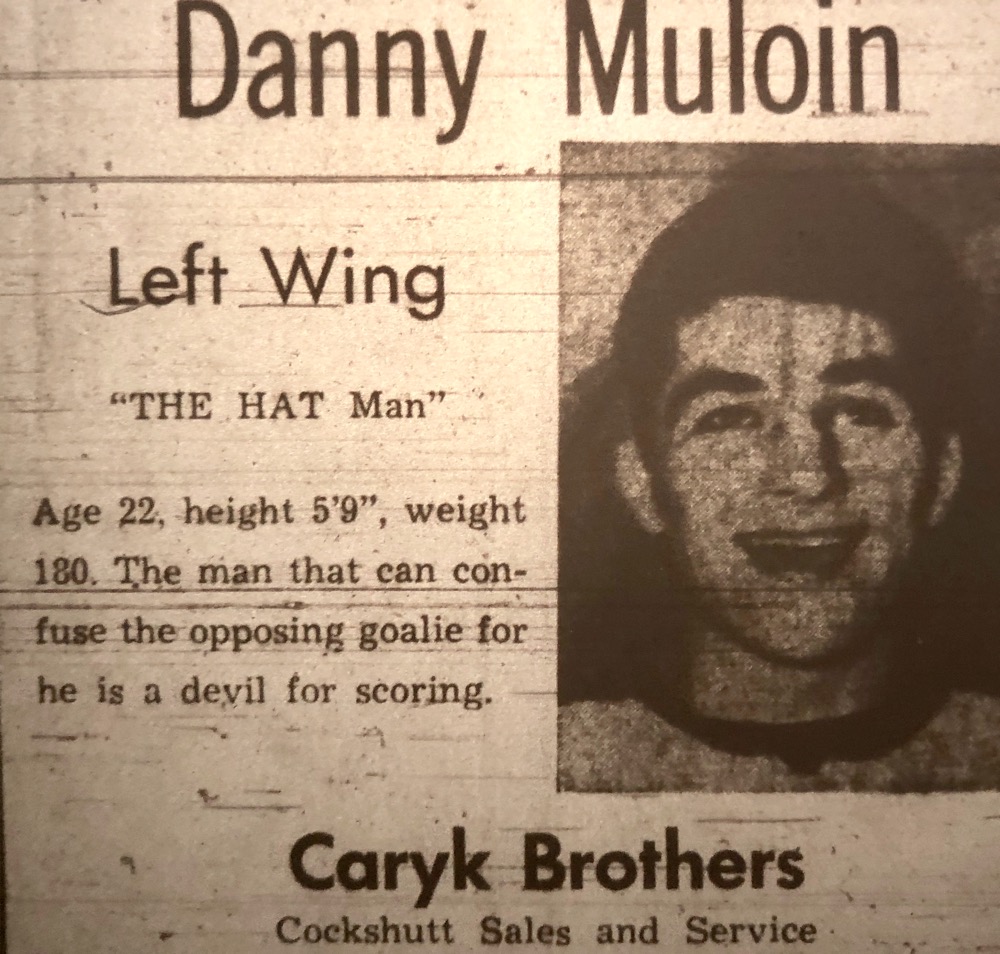
Danny Muloin was a scoring machine with the Rangers. Submitted photo
Ironically, I ran across John recently and reminded him of the days he sponsored this program by awarding a pair of hush puppies to any Athletic player who scored a hat trick during a home game.
“I had forgotten all about that,” said Wiebe. When we first moved to Grande Prairie and started our business in the early 1960’s we couldn’t afford to offer free shoes to anyone let alone a hockey player. As our business improved we got the idea and it became a staple in the hockey community.”
Pete Wright was a “no nonsense” playing coach for the Athletics. Danny was most certainly a good hockey player but perhaps a bit unreliable. That was confirmed for Pete when Danny failed to show up for a game during the 1962 season without notifying anyone. “Where is Danny?” growled Pete. “He knows where the rink is located”. “I don’t know.” responded As manager Barry Phillips. “ I never know what to expect of him.” Barry went on to acknowledge that Muloin was good although while playing with the As he never displayed the skills for which he was remembered while playing with the Rangers. Pete made it known that Danny had played his last game with the As. It was rumoured that Danny had moved to Edmonton but he notified no one and nobody knows for certain what happened to him thereafter. He was certainly a vagabond and “one of the restless kind” described by Robert Service. Possibly it was a genetic predisposition.
A championship earned on the Ice
Once again – fast forward to 2019. This season, fifty eight years later after the incidents reported above, camera in hand I had the pleasure of attending the As home games against the Canucks and believe me – they were worth watching. This season there were no forfeitures and no boardroom decisions to determine the league’s champions. Unlike senior hockey in 1961 it is no longer the only game in town on a cold winter night. Today we have our Junior A Storm that play in the Alberta Junior Hockey League and of course numerous other entertainment venues that compete for spectators. To attract a large audience you have to be good. I am here to testify that if you enjoy watching well played live hockey I urge you to become a fan of the NPHL.
In a recent article Chris Clegg who writes for the NPHL he comments, “Game 1 of the NPHL final (2019) marks the 100th meeting between DC and GP in their NPHL history (regular and playoff history combined)”.
According to his analysis by season’s end with Grande Prairie winning the series each team has won 54 games since the inception of the SPHL/NPHL. Interestingly in 1961 Dawson Creek, boasted a population that was slightly larger than Grande Prairie’s population of 8,500. Comparing populations today, Grande Prairie, with a population of 68,556 is approximately five times larger than Dawson Creek (12, 978). In spite of the difference in size the Dawson Creek Canucks continue to be as competitive as ever and are still running neck and neck with the Grande Prairie Athletics as if to some unknown finish line.
This year the As won the NPHL but not by virtue of hockey politics in a boardroom. In game six they defeated the plucky Canucks by a score of 3-2 in overtime. “It marked the 10th time in the 66-year history of the league the final was decided in overtime. How fitting was it that the two teams played into overtime to decide the series! In their NPHL history going into the game (including playoff) the teams had split their first 104 games with each team winning 52. (NPHL.com). As noted above with camera and notebook in hand I was privileged to attend the home games in Grande Prairie. On a number of occasions the fans were brought to their feet. It was exciting hockey. Unlike the Memorial Arena in 1961 when hockey was the only game in town not every seat in the Coke Centre was filled but the games were well attended and the fans were energetic in support of the talent that was displayed.
In the post war era of Grande Prairie hockey names like Charlie Turner and Pete Wright stand out. This year Dennis Rix stands out. Like Charlie and Pete he is a hometown boy, a shining example to young aspiring athletes and provides an example of the caliber of players that compete in the NPHL. Dennis played with the GP Storm along with GP Hockey Legend Carter Rowney when they won the Alberta Junior Hockey League (AJHL) in 2009.

Friends and long time teammates Blake Clement, Mark Stojan, Morgan MacLean and Dennis Rix were part of the AJHL 2009 champion Grande Prairie Storm. Can you identify them?
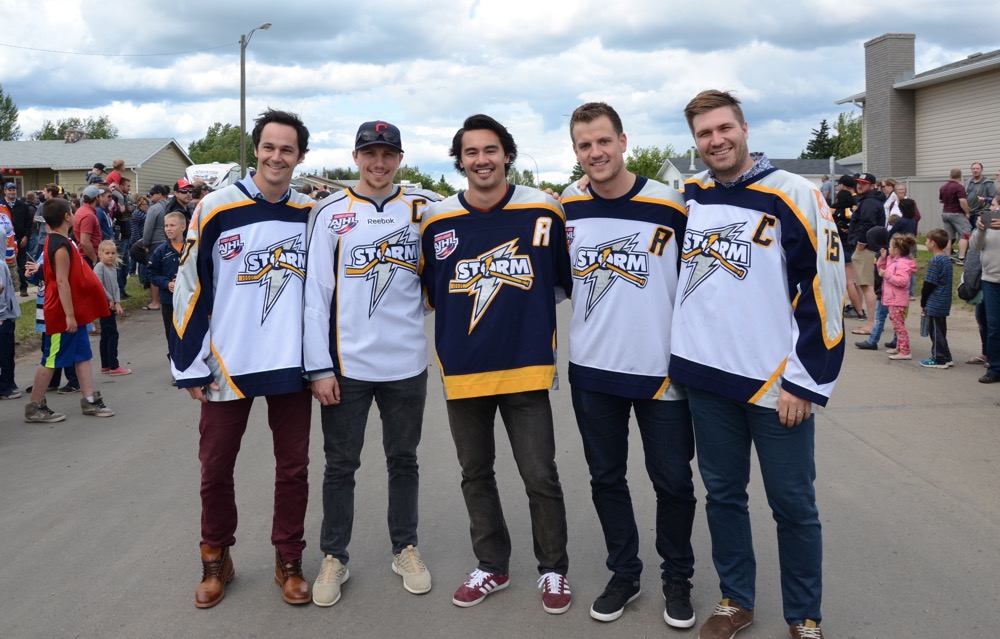
Morgan MacLean, left, Tanner Fritz, Dennis Rix, Mark Stojan and Blake Clement all took part in the July 2017 parade at Sexsmith for another “Home Town Hero” Carter Rowney.
“To win a championship at any level is pretty special.” Dennis reported during my interview with him and I could read the excitement in his eyes. (Stan Neufeld Interview). “This championship was particularly special as it was an experience I shared with local guys I have played with and against for years – since Atom , PeeWee and Bantam. They included Mark Stojan, Blake Clement, Mackenzie Caron and Morgan MacLean.

Golden Arrow Bantam AAA Storm Team photo. Photo Courtesy of Grande Prairie Minor Hockey.
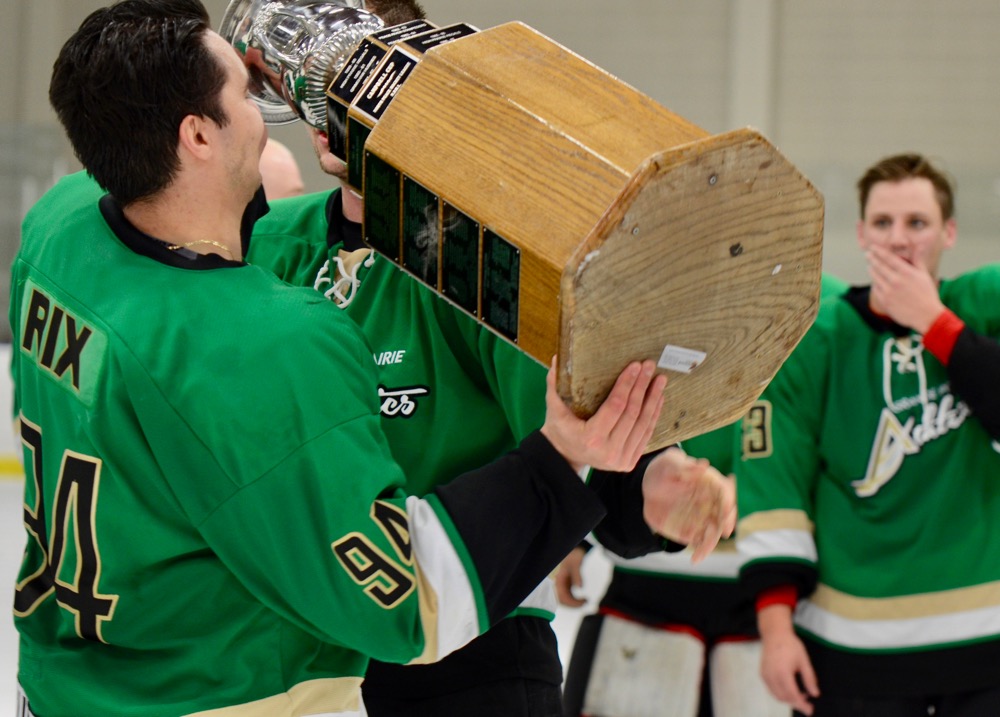
Dennis Rix with the Campbell Cup. Photo by Stan Neufeld
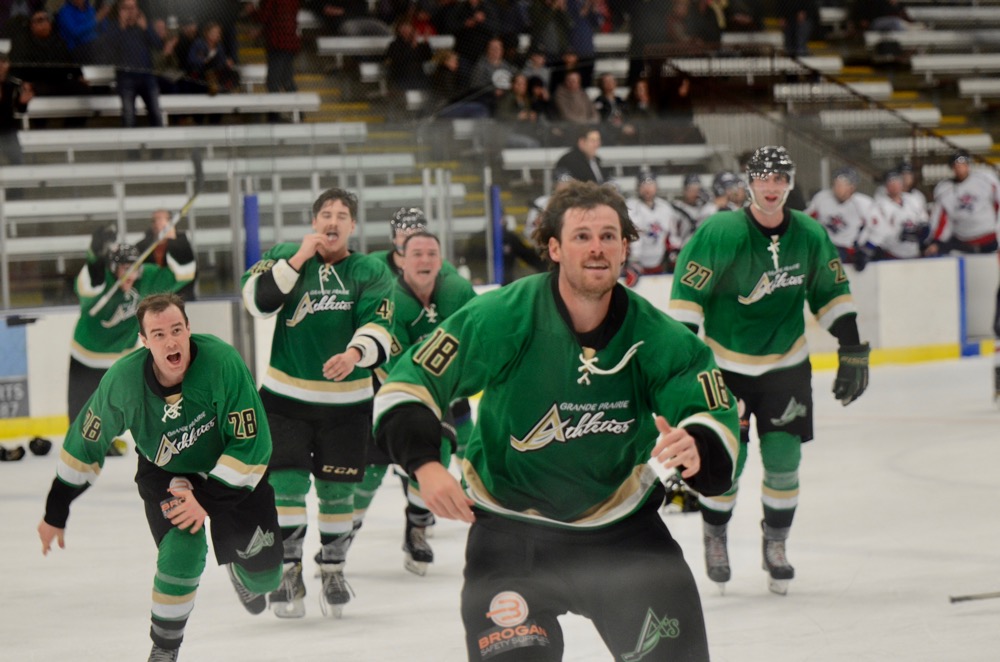
Players fly off the bench to mob Mackenzie Caron after his overtime game-winning goal. Photo by Stan Neufeld
Unlike the controversial final game in the 1961 series – this game was won on the ice not in the boardroom.
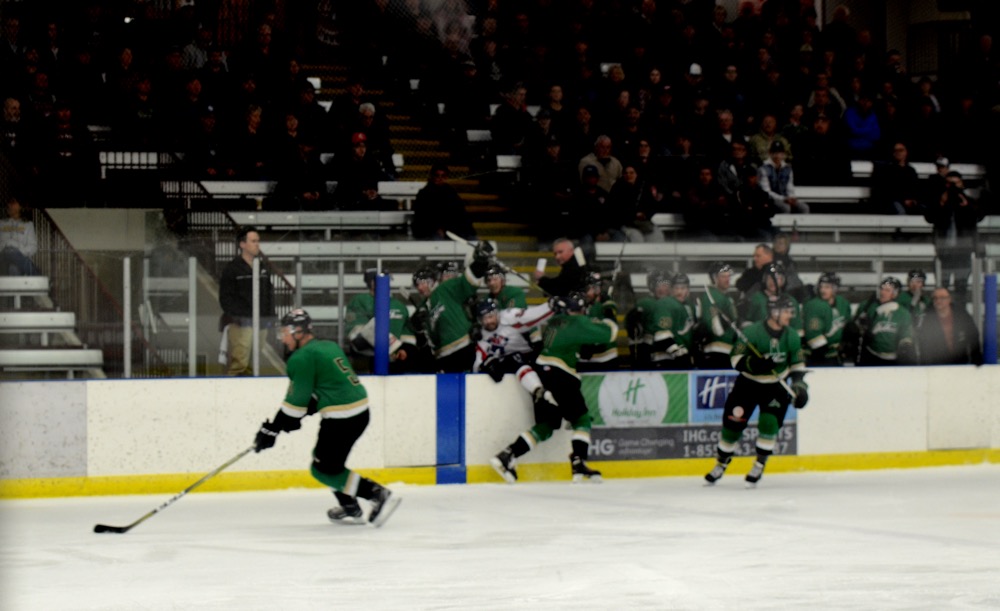
If you can’t beat em-join em. Canuck player ended up in the Athletics’ player box but it didn’t turn out as hoped for. Photo by Stan Neufeld

Dennis Rix was named the NPHL top face-off man. Photo by Stan Neufeld
Stan Neufeld
Grande Prairie Hockey Legends is researched, written and presented by Stan and Ron Neufeld